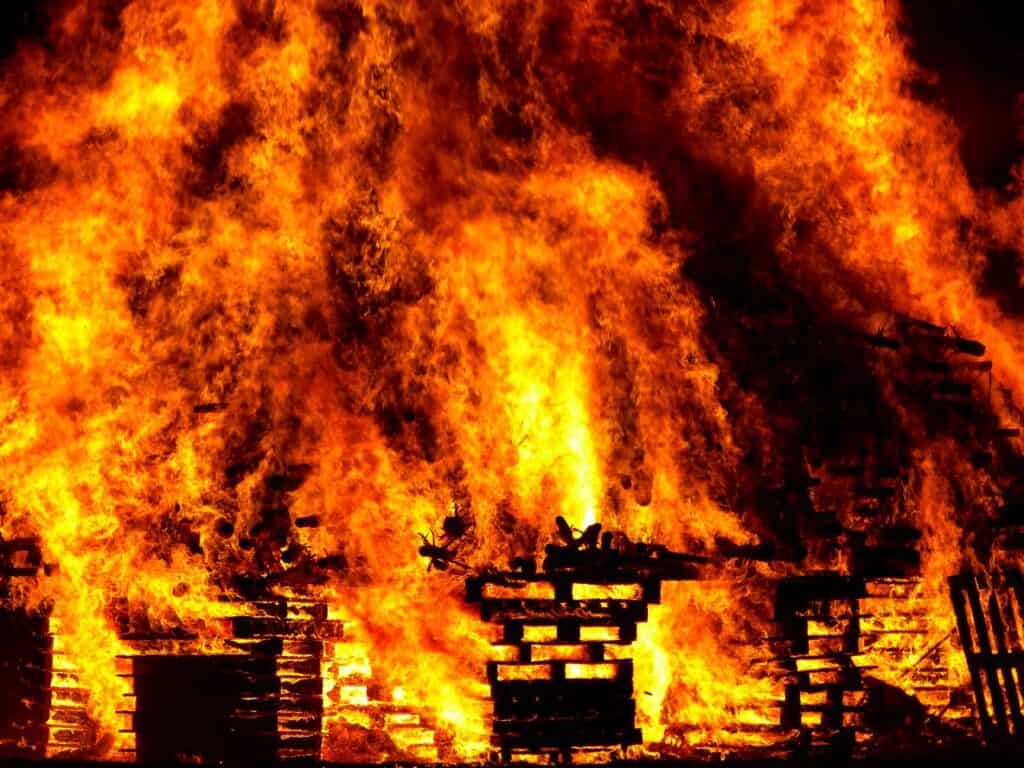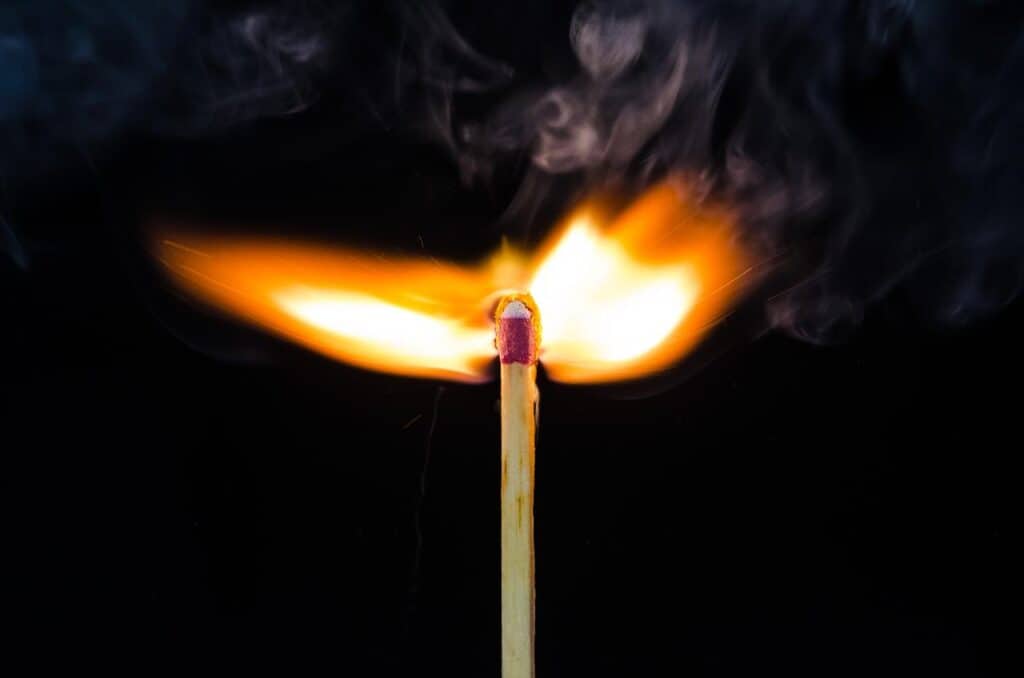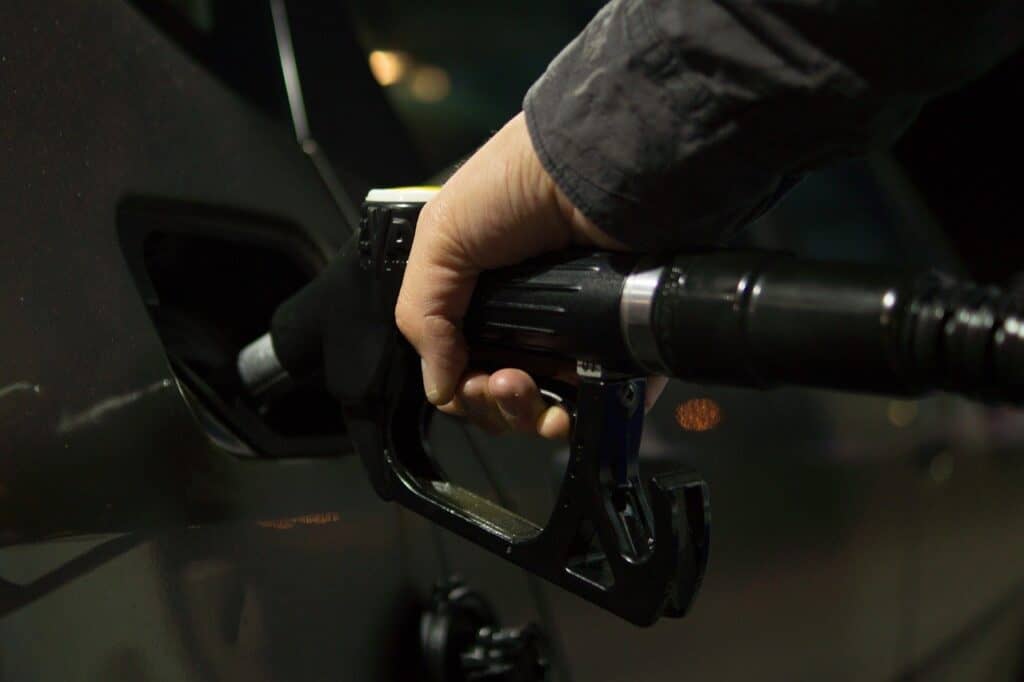Fire is one of the most terrifying reactions known to man. There’s something deep down in our souls that knows that heat and smoke and flame are not conducive to a happy existence. Even babies will flinch away from fire. But what is it that makes things catch fire and more to the point, how can you tell if something will burn easily and present a hazard that you and your family should avoid?
A material’s ability to ignite is dictated by the strength of bonds between molecules within the substance and the ease of oxidation. Though there are others, the most common definition for flammability is, “burns in the presence of a spark at under 199.4 degrees Fahrenheit”, as defined by OSHA 29 CFR 1910.106.
Flammability can be a complex topic. Lets take a look at fire, flammability and what exactly makes one material catch fire easily, while another not at all. Here’s what you need to know.
Your # 1 priority is keeping your family safe. As a firefighter, I recommend everyone has updated smoke detectors that don’t require battery changes, like these ones from Kidde, a fire extinguisher, like this one from Amerex, and a fire escape ladder if you have bedrooms above the first floor, I recommend this one from Hausse.
Also read: Is Diesel Fuel Flammable? Yes and No…
Flammability

A flammable material is something that can catch fire (ignite) readily at an ambient temperature. This means that, in practice, it will catch fire as soon as it is exposed to a naked flame or a spark without needing to be heated prior to this.
A material will not be uniformly flammable, and, in fact, different compositions of the same material can have very different responses to a naked flame.
As an example, consider wood dust (sawdust). Thanks to the individual particles being very small, they have a large surface area compared to the volume of the particle. This means when they are blown through the air, which leads to a very high oxygen to surface area ratio, and as such, wood dust is very flammable.
In fact, if you are in a room full of wood dust and someone is foolish enough to strike a naked flame, the odds are very good that you’re going to witness an inferno as the wood dust explodes.
Don’t try this at home, but take a look at a cannon created using sawdust as the fuel:
Then let’s look at paper. Paper is made of mulched wood. It’s the same material as the sawdust but in a slightly different form.
Paper is not going to explode if you light a naked flame, but if you do light a naked flame, you can usually burn paper in it (assuming the heat of the flame is sufficient to reach the ignition point of paper – which is, famously, 451 degrees Fahrenheit).
Then let’s think about a very heavy wooden table – the wood’s a couple of inches thick. It’s wood, just like the sawdust and the paper.
How easy is it going to be for you to set fire to that table with a naked flame?
Well, assuming you’re not using a flame thrower, it’s not going to be very easy at all. It’s not that you can’t burn a wooden table, of course you can, but you can’t do it anywhere near as easily.
So wood can be highly flammable or it can be very difficult to burn.
Also read: How Hot Does Wood Burn? Examined
What Makes Something Flammable?
We will look at flammability, that is the ease of which that things catch fire, in chemical terms a bit later in this article.
But to begin with, it’s important to try and visit “flammability” as it is defined in terms of hazards and international standards.
And that’s hard because there are a ton of different standards out there.
Reasonably speaking, a liquid is considered to be flammable, in the United States (OSHA and NFPA), as any liquid that catches fire below 100 degrees Fahrenheit (that’s about 38 Celsius).
The temperature at which a liquid can catch fire is known as the “flash point” or, sometimes particularly in the cases of oils, the “smoke point”.
So far, so straight forward, right?
Well, no.
The United Nations defines “flammable liquids” as those which ignite above 0 degrees Fahrenheit and below 140 degrees Fahrenheit.
That’s a very substantial difference. While the United States’ definition, essentially, captures all liquids that burn at room temperature (even if you might need a very hot day to get to the top end of the scale).
The United Nations’ definition captures a bunch of liquids where you’d need a day hotter than any history to get them to burn.
The definition for a flammable solid can be based on the temperature or on the simple observation that any solid that burns immediately on exposure to a naked flame, spark or friction is flammable.
This means that you can’t easily define whether something is “flammable” and expect another person to understand exactly what you mean by “flammable”.
Also read: What Is The Temperature Of Fire? How Hot Does it Get?
What Makes Something Combustible?
As you might expect, this makes defining “combustible” quite challenging too. If there’s no absolute definition of flammability, then there is no absolute definition of combustibility.
In fact, the easiest way to understand “what is the difference between combustible and flammable?”, might be to determine that a material is combustible if it can catch fire and isn’t considered to be flammable.
However, while this is how we’ve worked things on this site – this isn’t how combustibility is measured everywhere. In fact, some places only consider combustibility and don’t consider flammability at all.
This is because at the heart of the concept of “combustibility” is a definition that combustibility is simply a measure of how easily things will burn. Yes, this makes for a fair amount of confusion when people start to look at flammability and combustibility.
The easiest way to resolve this confusion, of course, is to decide which authority you’re going to use and then take their definition. You can choose the Canadian Building Code, the US OSHA regulations, the United Nations transport definitions, or any other definition that you think will make life easiest for you or which you’re required to adhere to by law.
For example, the British Standard (BS) for combustibility is 76-4:1970 and it requires a technician to heat three samples of a given material in a furnace.
It says,
“a material is combustible unless it fails to burn for 10 seconds or more inside the furnace or fails to catch fire as the temperature of the furnace rises from the initial temperature to 50 degrees Celsius higher.”
Here is a demonstration of a flammable vs. a combustible liquid using USA standards:
Also read: Is Fire Flammable? Can It Make More Fire?
Is Flammable Or Combustible More Dangerous?
It will depend on how you define “flammable” and “combustible”.
If we use the idea of flammability as being anything that catches fire on exposure to a naked flame at an ambient temperature and combustible as anything that burns that isn’t flammable – then it’s obvious that flammable materials pose a higher risk of catching fire than combustible ones.
But as to which is more dangerous?
The ignition temperature of pure alcohol is at around room temperature. Whereas the ignition temperature of TNT (dynamite) is at about 176 degrees Fahrenheit.
Our definition would contend that the alcohol was flammable and the TNT just combustible.
But which would you rather be trapped in a room with? A burning glass of vodka or a burning stick of dynamite?
It’s important to understand that flammability/combustibility is only one element of risk when it comes to fire and not the whole question.
That means you can’t say which is more dangerous with any absolute definition. Alcohol, for example, burns cleanly – in that room with a burning glass of vodka the air quality will stay the same.
A rubber tire, on the other hand, which is not very flammable, but certainly combustible, will emit toxic fumes as it burns. Breathing in the hydrogen cyanide that it emits will not be good for your health.
What we can be clear about is that a flammable substance, assuming we use our initial definition, burns far more easily than a combustible one and should be kept well away from a naked flame or any other potential source of ignition.
Hear the technical difference explained in this video:
The Difference Between Ignitable And Flammable
We’ve used flammable to denote anything that burns readily at an ambient temperature. That means that anything that is flammable is ignitable.
However, that doesn’t mean that anything that is ignitable is flammable. If something is ignitable, it just means it will catch on fire. It makes no reference to a given temperature or set of conditions.
In reality, almost any substance is ignitable under the right conditions, though it may not sustain a flame.
Also read: Burning vs. Melting: What’s The Difference?
What Makes An Element Flammable?
Element is a chemical term that means,
“a pure substance consisting of only one element from the periodic table”
We don’t encounter those very often in real life.
What we do encounter, mainly, are compounds.
It is the individual elements within the compound and the strength of the bonds between them that tend to determine flammability, though there is one other consideration to be taken into account – has the element already been burnt?
So, for example, substances that burn easily often have a lot of carbon and hydrogen in them (hydrocarbons). That’s because these are the common building blocks for a lot of substances.
Flammability Examples:
Alcohol
Alcohol, from our earlier example, is Carbon, Hydrogen and Oxygen and because it’s a liquid at room temperature – the bonds between molecules are very weak (they are weaker still in gas/vapor and stronger in solids) and easy to break.
All you have to do is break the bonds in the alcohol to get it to catch fire. As alcohol is flammable, by our definition, at ambient temperature, it won’t surprise you to learn that these bonds are fairly weak too.
And once the alcohol begins to burn, burning carbon and hydrogen is exothermic (that is it releases heat) and this means that the burning reaction will self-propagate and needs no more help to burn as long as there is enough oxygen present.
Also read: Is Whiskey Flammable? Will it Catch Fire? Yes and No…
Wooden Table
Arrange some carbon, oxygen and hydrogen atoms a bit differently, on the other hand, and you might have our wooden table from our very first example in this article.
Here, the table is solid and that means the bonds between molecules are strong and, in fact, in a large piece of wood, those bonds are very strong. That is why the table doesn’t burn easily even if other wood products do.
In sawdust, most of those inter-molecular bonds are gone and thus, it’s easier to burn wood in that form.
Sand
Sand, on the other hand, won’t burn.
It can be burned if you heat it up to an incredibly high temperature, which breaks it back down into its individual atom,s but that’s because the Silicon in the sand will burn, but it’s no longer sand when it does burn.
Sand is Silicon Dioxide.
That is Silicon which has bonded completely with oxygen.
From a chemical standpoint – sand is what you get when you burn silicon. There’s nothing left to burn.
So sand is neither flammable, nor combustible.
How Do You Know If Something Is Flammable?

You cannot tell if a substance is flammable or combustible just by looking at it.
The good news is that, in most cases, you probably won’t need to.
If it’s a substance that you are bringing into your home or office – if it burns easily, it will probably have a warning label on it to explain how easily it burns and how you can prevent that.
Otherwise, you may need to look it up online.
As a rule of thumb, things with high water content won’t burn easily because water doesn’t burn.
But, if you evaporate the water content (by keeping the object over 100 degrees Celsius or 212 degrees Fahrenheit) what’s left behind might burn.
If you don’t know whether something is flammable or not – it’s best to assume that it is flammable and keep it away from naked flames or other potential sources of ignition.
Also read: Is Smoke Flammable? You May Be Surprised…
Where Does The Word Flammable Come From?
The word flammable has been brought into the English language via French from Latin.
The original “inflammare” means “to set fire to” and flammable is simply a contraction of that with an Anglicization of the original word.
Inflammable vs. Flammable: The Difference

Inflammable means “flammable”. The two words are completely interchangeable.
We should be able to cut a little confusion off at the pass here thanks to this understanding of how the word “flammable” originated.
It might seem obvious that “inflammable” is the opposite of “flammable” as “invisible” is the opposite of “visible”.
However, this is one of those odd words in English that don’t obey the rules of standard grammar (and there are a lot of words that refuse to follow the rules in this language).
In fact, the word “flammable” wasn’t in common usage until around the 1950s, when the UK and the USA both decided to standardize on flammable in preference to inflammable.
If you need to use the opposite of flammable then you need to use “non-flammable”, “non-inflammable”, “incombustible”, “non-combustible”, “not flammable” or “fireproof” instead.
Final Thoughts
As you’ve seen “what makes something flammable” is a complicated question and it’s not always easy to tell whether a material will or won’t be flammable.
It would be useful if international bodies could at least standardize the conditions under which something is considered flammable – then we could all, at least, talk in the same way about “flammability” and be sure that the other person in the conversation understood what we meant.
However, as this seems unlikely to happen, for now, the best thing to do is treat materials as flammable, unless you know they are not, and practice basic fire safety all of the time. If in doubt, you can always look up information regarding flammability and combustibility online and make informed decisions.
Related Articles
Is Fire Alive? Properties and Stages of Fire and Flames
Is Engine/Motor Oil Flammable? You May Be Surprised
Is Hydrogen Peroxide Flammable? Examined

